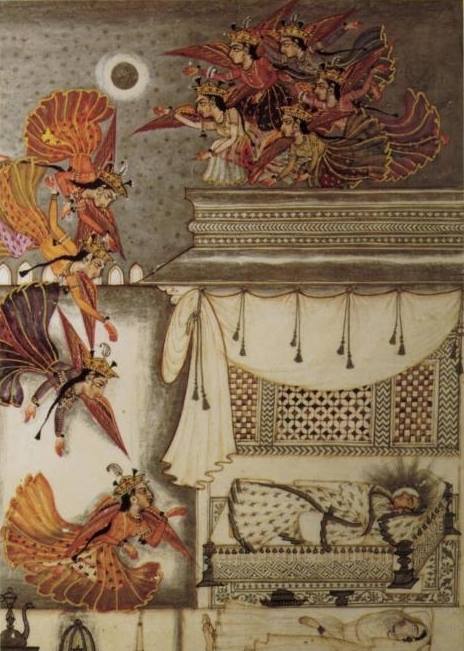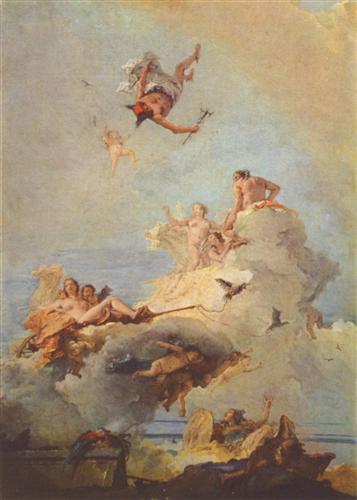A painting card on my table
M: M, you cannot write. just take notes. if these few painting postcards are your material for the day, look at it closely, write about it as a way of entering the material.
Painting 1. A royal woman sleeps in her chamber of marble and fur (because that is what that paint does, bridges the distance between the textures of marble and fur. She sleeps and the houries come, wearing qawwali caps, in orange and just a bit of bum pink, the flying women minstrels make a margin around the page of the marble boudoir. If the painting is a pattern and the volumes need to be communicated, then the page metaphor might work. A sleeping chamber in marble and fur textures, in intricate cat greys and cat whites, is the main page of the notebook, the houries are the margin of the notebook page. The margin is prominent because the Houries are heavenly beings, therefore the space of the margin is large, larger than the space for the centre.
the heavens are the full page in the other card: Tieopolo, a new discovery, from a chance interview read online, of Calasso. Hill clouds well watched over days, cloud light watched for hours and practiced, till,the clouds and light are almost biblically known to the painting arm, and thus known, they now yield living beings that rest, gambol, move on massive cloud surfaces, sun on their torsos, shade on their groins. The idea of the skies much more vast and large than the idea of the beings that live among them and so the flesh and bone form of those figures convincingly live among the soft but strong volume of the clouds. Tieoplo's heavens of daylight and the Deccan painter's night, and heavenly beings in both. Tieoplo's beings need no wings, their bodies are made for the playground of the clouds. A baby does a sky dive somewhere in the depths of the frame, while the adults pose upfront. In my mind the two skies, at different times of day- are on continuum, the one large sky, getting more and less light at different times of story. Rome and Hyderabad are small beings, as big as a patch on the arm of one of the angels, looking up.
I did an attempted photoshop, taken up by the conceit that the women houries might be framed against the freewheeling child diving into the skies, head first.. the satan like figure, flying mid space among the hourie spaces ..but my image work is merely a desire yet, writing it must be for me, for now. Meanwhile, N meets a young painter, water colourist of motor boats leaving old mythically named jetties, old factories reflected in water and sky.. young, shyly smiling, stumbling around language, living in what he is doing.
Returning to the sky of the miniature- embedded with a disc of beaten gold, a golden moon! with a beaten gold pattern spread across the skies, glory, excess.
The wall of the compound becomes the threshold of the human world, watery marks of an ageing wall over which splendid houries fly. Maybe water is a human element, the gods do not have it? The human being resting on the cot, still belongs to the material land of the wall, inhabits those colours, but wears, edging her greys and white, those golden and rich maroon marks as a sign of desire for another world. She lies like the quiet moon, in her chambers, the houries are drawn irresistibly to her. She shares some skin tones with the houries though, then what makes her distinctly human, only her dress?
Then the maid who lies on the floor, not coloured in completely, with less aspiration to anything else, the painting tells us, her flesh not shared with the queen of the houries, her tones even closer to the floors, the human walls of the chambers. The painter by convention must undifferentiate her, and i also almost forget her ( just that ambedkar is on facebook these days all the time and creeps into my margins and makes those margins alive) in that white cream material where her skin and cloth are almost one, she is quietly more ethereal. the Houries (unfacebooked) still lack the imagination to see, the queen shares flesh tones with them and so they love her difference from them- their love for her is then maybe a seeking of themselves, like all love. the servant..
Calasso writes of mythology.. This comes from Plato, from the Phaedo. Socrates says that precisely. Within the realm of myth, you wander into this danger zone, and that is the zone of the unknown. What you can do there is, first of all, utter or sing a carmen, a word that is usually translated as “poem” but primarily means “enchantment.” That is the best weapon at our disposal.
We are already there. As Sallustius the Neoplatonist wrote, the world itself is a myth. So no matter what we are doing, we are in the midst of a fable. And fables are by definition what enchant us. The only question is whether we perceive it or not.
Myths are not invented, they are there. You cannot say a myth starts at a certain moment.
And myth is never a single story. It is always a tree with many branches. Unless you take into account all possible variants, you don’t truly understand it.
excerpts from Calasso interview
The gods come afterward. In India the gods are latecomers. First there is Prajapati, and we just don’t know who he is—and he doesn’t know either, which is the disquieting point. Then come the rishis, the seers. Then finally come the gods—and they are not taken so seriously. Indra, who is the king of the gods, is made a fool of very often in Indian myths. This happens far more often in Indian lore than for his equivalent in Greek myth. At the end of all are animals and men.
Well, you find that notion already in Genesis. But that has its own consequence—guilt. Guilt lies at the root of sacrifice. Sacrifice is not a way to avoid guilt or to excuse guilt, it is a repetition of guilt. In a sense, it’s a reinforcement of guilt. The first guilt is the very fact of making things disappear. Killing is only one of the ways of achieving that. Eating is another.
These actions are all very closely connected and they reach very far back into prehistory. They have gone on for hundreds of thousands of years and have thus left their traces in our minds. You can take them into account or ignore them. Our world attempts to ignore them, it considers all of these things as very remote. In my books, I try to unearth them.

